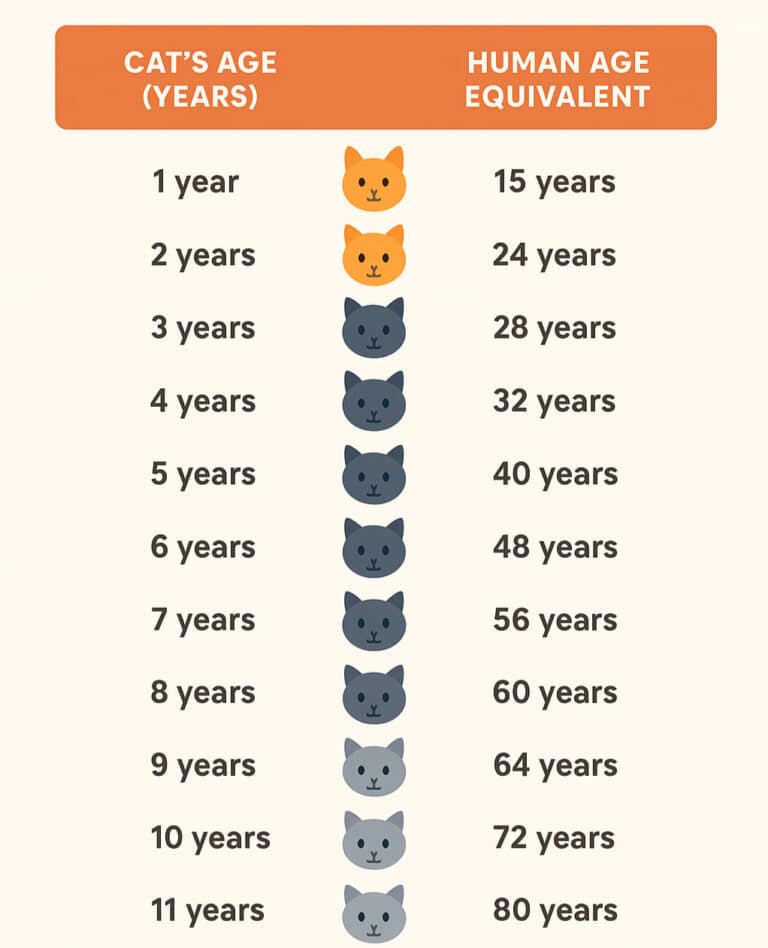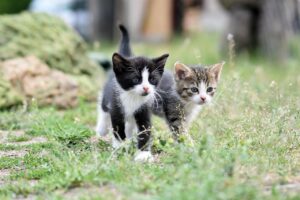Cat Age in Human Years
Calculate your cat's age in human years accurately
🐱 Cat Life Stages
- Kitten (0-1 year): Rapid growth and playful development
- Young Adult (1-3 years): Active and energetic period
- Prime Adult (3-6 years): Peak health and maturity
- Mature Adult (7-10 years): Still active but may slow down
- Senior (11-14 years): May need extra care and comfort
- Geriatric (15+ years): Requires special attention and monitoring
How to Calculate Cat Age in Human Years?
If you’ve got a cat at home, you’ve probably wondered at some point, “How old are you really, in human years?” I know I did with my own cat. She turned one, and everyone kept saying, “Oh, she’s like seven in human years.” Turns out… that’s not actually true. The whole “one cat year equals seven human years” thing is just a myth that stuck around.
Cats age a lot quicker in the beginning and then slow down later. So if you want to figure out cat age in human years, there’s a much better way to do it.
A Simple Way to Do the Math
Here’s what most vets use (and it makes way more sense than the 1:7 rule):
Year 1 of a cat’s life = about 15 human years
Year 2 = another 9 years (so a 2-year-old cat is like 24 in human years)
After that, each year adds about 4 human years
So if your cat is 5 years old, that works out to about 36 human years. That’s basically a middle-aged adult! My 8-year-old cat is pushing into the “50s” in human terms, which honestly explains why she prefers naps over chasing toys these days.
Why Does Cat to Human Years Matter?
Well, apart from being fun trivia, it actually helps you understand what stage your cat is in. A one-year-old cat isn’t really a “baby” anymore — they’re more like a teenager. By the time they’re two, they’re in their mid-20s. And once they get to 10 or 12, you’re looking at a senior cat who needs a bit more care, just like we would at that age.
When you think about cat to human years, it kind of puts their behavior into perspective. That crazy kitten energy? Totally normal — they’re basically toddlers on sugar. That 12-year-old cat who sleeps all day? Also normal — you wouldn’t expect a 65-year-old person to run around nonstop either.
The Takeaway
At the end of the day, converting cat years vs human years doesn’t need to be exact. It’s just a way to help us understand our pets better. And honestly, it makes you appreciate the time you have with them even more.
Cat to Human Years Chart
If you’ve ever caught yourself wondering how old your cat would be if they were human, you’re definitely not alone. Many cat parents talk about cat age in human years because it’s easier to relate to. After all, saying your cat is “10 years old” doesn’t feel the same as saying they’re the equivalent of a 56-year-old person.
Why Cat Years Don’t Match Human Years
People often compare pets to humans, but when it comes to cat years vs human years, the numbers aren’t a simple one-to-seven formula. Cats grow up incredibly fast in their first two years. By their first birthday, your cat is already like a 15-year-old teenager. By the second, they’re closer to 24 in human years. After that, each year adds about four human years.
This is why a cat to human years chart is more accurate than the old myth. It gives you a realistic idea of whether your pet is in their “youth,” “middle age,” or “senior” stage.
Why Knowing Cat Age in Human Years Helps
Understanding your cat’s age in human terms isn’t just fun — it’s useful. A 2-year-old cat is like a young adult, active and playful. But a 12-year-old cat is closer to a senior in their 60s, which means they may need softer food, more frequent vet visits, and extra comfort at home.
By comparing cat years vs human years, you’ll get a clearer idea of what stage your cat is in and how best to care for them.

Why Do Cats Age Faster Than Humans?
If you’ve ever raised a kitten, you know how fast they grow up. One moment they’re tiny fluffballs who can barely climb the couch, and a year later, they’re prowling around like they run the place. It feels like they skip from baby to teenager almost overnight. That’s because cats age on a totally different timeline than we do.
When you compare cat age in human years, the first year of their life is like a huge leap — about 15 human years. By the time your cat turns two, they’re around 24 in human years. After that, things slow down a little, with each cat year adding roughly four human years.
So if you’ve got a 7-year-old cat, in cat years vs human years, that’s basically someone in their mid-40s. And if your kitty is 12? That’s like a 65-year-old person — no wonder they spend most of the day napping. Thinking in terms of cat to human years really helps explain their behavior and energy levels.
The bottom line is this: cats don’t get to stay “kids” as long as we’d like. Their bodies just move through life stages faster. Using a cat year to human years chart makes it easier to keep up with them — and it reminds us to give extra care as they grow older.
Tips to Keep Your Cat Healthy at Every Age
Knowing that cats age quickly is one thing. The real trick is keeping them happy and healthy at every stage. And for that, it helps to think in cat age in human years terms.
Kittens and Young Cats (0–2 years): On the human scale, this is like going from a toddler to a 24-year-old adult in just two years. Crazy, right? At this stage, your cat needs good food, safe play, and plenty of attention to burn off all that wild energy.
Adults (3–10 years): Now we’re talking mid-20s to late 50s in human years. Your cat may calm down a little, but they still need exercise, checkups, and a balanced diet to stay in shape.
Seniors (11+ years): Once you hit this stage, you’re basically caring for someone in their 60s or 70s. That means softer food, comfy spots to rest, and more frequent vet visits.
When you look at cat years vs human years, it’s obvious that their needs change pretty fast. My own cat is 9, which makes her about 52 in human years. She still plays sometimes, but naps are her favorite thing now — and that’s perfectly normal.
So here’s the takeaway: don’t just count birthdays. Think in terms of cat year to human years, and you’ll have a much better sense of what your cat needs at every step of their life.


